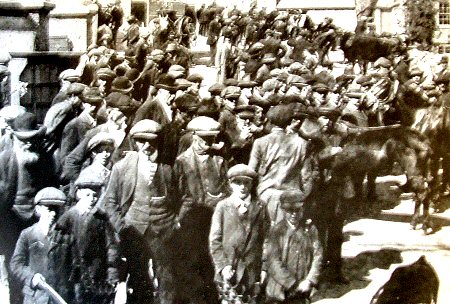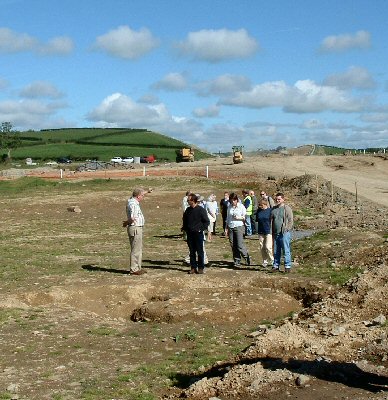As stated on our Newry Workhouse series, Dessie McGennity’s family moved from the workhouse to the castle above Chapel Street’s High Walk. Des was only seven years old and remembers how frightening it could be. On winter’s nights the wind howled ‘like a Banshee’ and made the shutters bang. It was bitterly cold with the stone floors, walls and stairs. There was an absence of heating and the outside toilet was ‘little more than a hole in the ground’.
History
Shipping Losses
We all recall from our school days, tales of cruel shore people luring ships’ captains unto rocks with bright lights. They were after the spoils of wrecks, and they cared not at all for the watery fate of sailors
Newry Military Barracks
The White Linen Hall in Newry was built about 1783 to promote the direct export from Counties Down and Armagh of linen products manufactured there and to bypass the services of dealers in Dublin. The spinning-wheel motif and the crowned harp on the piers of the gate date from this period. The crowned harp symbolises the involvement of the state with the linen industry of the time.
Crossmaglen 1838
The Ordnance Survey Reviews of times long ago make interesting reading, from time to time. Compare Crossmaglen today with that depicted below!
Church at Kilnasaggart?
The Kilnasaggart Stone plaque recently referred to continues with a description of its carvings:
‘On the north-west face are ten carefully-carved crosses, nine of them within circles and, low down, a number of parallel linear marks, once interpreted as a possible ogham inscription but actually knife-sharpening score marks. Traditionally a crock of gold was buried below the pillar and it was overturned by treasure-seekers in the 1830s, but it was soon reset.
Excavations in the 1960s to the south of the pillar revealed a number of both stone-built and dug graves, probably dating from the Early Christian period. A map of 1609 shows a ruined church in this area but there are no visible remains and no trace was found during the excavation.’
Your editor considers that the early 1960s excavations of this, the Slieve Gullion tombs, Ballymacdermott Court Cairn etc. were less that complete and must at best be treated as indicative. We baulk at terms like ‘actually’ above, used in relation to a dubious theory at best. The stories of the cemetery excavation – and the overturning of the pillar in search of booty – have already been related here. The sentence beginning, ‘Traditionally a crock of gold was buried below the pillar..’ is at best unclear and at worst an unintended enticement to further vandalism. There is certainly no evidence to support the allegation. There is no indication of the possible greater antiquity of this standing stone already debated here (and on Guestbook).
Though there is no extant evidence of an early church on the site, we believe the circumstantial evidence (the location at the Gap of the North on the ancient Slighe Miodluachra (next story!); the overscored Christian symbols on a more ancient pillar; the nearness of Moninna’s convent at Killeavy and that of Bridget at Faughart; the 1609 map; the name, Kilnasaggart meaning Church of the Priest) points to that distinct possibility.
Poor Law and Tramps
John Mitchel is even today frequently lambasted for claims he made that British policy towards Ireland after the Union was deliberately designed to remove the great mass of poor from their holdings, the land, the country and the face of the earth. Yet Reports from Commissions of Inquiry set up by successive British governments – and action (and inaction) taken as a result – give strong if circumstantial evidence in support of Mitchel’s words.
The Devon Commission of 1833 estimated that of the country’s population of over 8 million, some 2,385,000 were ‘in great need of food’. Its strong recommendations for urgent investment in wealth- and employment-creating schemes went unheeded and the Government went ahead with the Workhouses designed to deter the ‘work-shy’. The subsequent potato failure and Great Hunger, disease, campaign of farm-amalgamation, dispossession, eviction and enforced emigration saw a massive shift in the population profile by the end of the century. The Vice-Regal Commission on Poor Law Reform 1906 blamed famine, disease, eviction and emigration which affected the poorer classes more than most.
The latter Commission in 1906 estimated some 30,000 of a population of four and a half million to be dependent upon Poor Relief. (The numbers again dropped dramatically from 1908 onwards with the introduction of Old Age Pensions). This was less than one per cent compared with thirty per cent of a population twice the size, some seventy years previously.
Where had they all gone? We will soon upload a personal story of an ‘American Wake’. A sizable fraction of those who had not fled the country had died of disease or hunger. The suffering of the poor was hugely disproportionate as a result of deliberate Government policy.
Of the 30,000 mentioned, some 2,000 were classified as vagrant or tramps. The Commission estimated that eighty per cent of these were male. They were of two types, one being old and infirm but basically decent and generally well-known and respected within their own locality. The other type has for centuries been the greatest object of hatred for governments: the ‘young and able, lazy ne’er-do-wells, dishonest and potentially dangerous’. The Commission recommended the setting up of Labour Houses wherein they might be confined to learn ‘habits of sobriety, regularity and industry’.
The Newry Reporter and other local papers reported the activities of tramps in this area – ‘infested with a tramp plague’ was a commonly heard expression – and special courts were frequently convened to deal with the problem. For begging, two months in prison with hard labour was a regular sentence.
Yet then (and before and since!) there was a great deal of local sympathy especially for those tramps who were recognized simply as colourful characters.
We have featured a number. Later a few more.
Sligh Miodluachra
Five great roads emanated from the Hill of Tara in Meath (once again in the news as Bertie’s government controversially determines to drive a motorway through the vicinity!) to the rest of Ireland. The northern-bound road, the Slighe Miodluachra, meaning the way of the middle rushy place, was well-named certainly as it traversed the Gap of the North at the townlands of Carrickbroad (the robber’s rock) and Edenappa. This is the location of Kilnasaggart.
Abbey Newry History
Scanning the Down & Conor Historical Society Journal of 1938 recently I found the following entry which I now include as it opens a few new pieces of information (well, new to me!). The transcription below is not exact.








